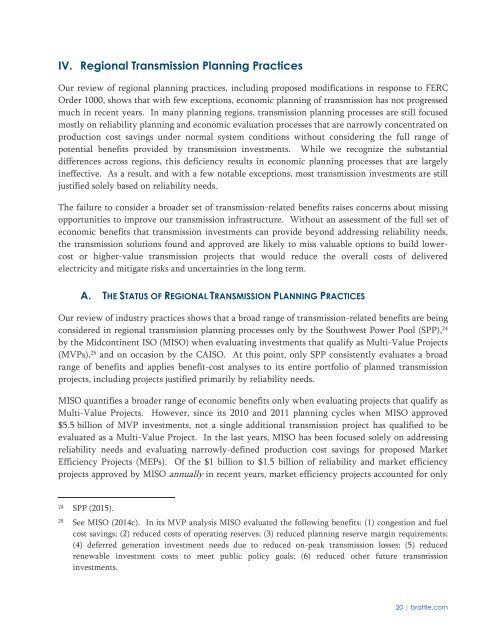THE BRATTLE GROUP
pvrbYG
pvrbYG
Create successful ePaper yourself
Turn your PDF publications into a flip-book with our unique Google optimized e-Paper software.
IV. Regional Transmission Planning Practices<br />
Our review of regional planning practices, including proposed modifications in response to FERC<br />
Order 1000, shows that with few exceptions, economic planning of transmission has not progressed<br />
much in recent years. In many planning regions, transmission planning processes are still focused<br />
mostly on reliability planning and economic evaluation processes that are narrowly concentrated on<br />
production cost savings under normal system conditions without considering the full range of<br />
potential benefits provided by transmission investments. While we recognize the substantial<br />
differences across regions, this deficiency results in economic planning processes that are largely<br />
ineffective. As a result, and with a few notable exceptions, most transmission investments are still<br />
justified solely based on reliability needs.<br />
The failure to consider a broader set of transmission-related benefits raises concerns about missing<br />
opportunities to improve our transmission infrastructure. Without an assessment of the full set of<br />
economic benefits that transmission investments can provide beyond addressing reliability needs,<br />
the transmission solutions found and approved are likely to miss valuable options to build lowercost<br />
or higher-value transmission projects that would reduce the overall costs of delivered<br />
electricity and mitigate risks and uncertainties in the long term.<br />
A. <strong>THE</strong> STATUS OF REGIONAL TRANSMISSION PLANNING PRACTICES<br />
Our review of industry practices shows that a broad range of transmission-related benefits are being<br />
considered in regional transmission planning processes only by the Southwest Power Pool (SPP), 24<br />
by the Midcontinent ISO (MISO) when evaluating investments that qualify as Multi-Value Projects<br />
(MVPs), 25 and on occasion by the CAISO. At this point, only SPP consistently evaluates a broad<br />
range of benefits and applies benefit-cost analyses to its entire portfolio of planned transmission<br />
projects, including projects justified primarily by reliability needs.<br />
MISO quantifies a broader range of economic benefits only when evaluating projects that qualify as<br />
Multi-Value Projects. However, since its 2010 and 2011 planning cycles when MISO approved<br />
$5.5 billion of MVP investments, not a single additional transmission project has qualified to be<br />
evaluated as a Multi-Value Project. In the last years, MISO has been focused solely on addressing<br />
reliability needs and evaluating narrowly-defined production cost savings for proposed Market<br />
Efficiency Projects (MEPs). Of the $1 billion to $1.5 billion of reliability and market efficiency<br />
projects approved by MISO annually in recent years, market efficiency projects accounted for only<br />
24<br />
SPP (2015).<br />
25<br />
See MISO (2014c). In its MVP analysis MISO evaluated the following benefits: (1) congestion and fuel<br />
cost savings; (2) reduced costs of operating reserves; (3) reduced planning reserve margin requirements;<br />
(4) deferred generation investment needs due to reduced on-peak transmission losses; (5) reduced<br />
renewable investment costs to meet public policy goals; (6) reduced other future transmission<br />
investments.<br />
20 | brattle.com


